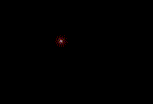
to go back
The Guide to the Old North State, prepared by the W.P.A. in the 1930s, states that the Brown Mountain Lights have "puzzled scientists for fifty years." The same story reports sightings of the lights in the days before the Civil War.Cherokee Indians were familiar with these lights as far back as the year 1200. According to Indian legend, a great battle was fought that year between the Cherokee and Catawba Indians near Brown Mountain. The Cherokees believed that the lights were the spirits of Indian maidens who went on searching through the centuries for their husbands and sweethearts who had died in the battle.
There are innumerable stories of the lights. But perhaps the best description is that the lights are "a troop of candle-bearing ghosts who are destined to march forever back and forth across the mountain."
The lights can be seen from as far away as Blowing Rock or the old Yonahlosse Trail over Grandfather Mountain some fifteen miles from Brown Mountain. At some points closer to Brown Mountain the lights seem large, resembling balls of fire from a Roman candle. Sometimes they may rise to various heights and fade slowly. Others expand as they rise, then burst high in the air like an explosion without sound.
Late in 1919 the question of the Brown Mountain Lights was brought to the attention of the Smithsonian Institution and the United States Weather Bureau.
Dr. W.J. Humphries of the Weather Bureau investigated and reported that the Brown Mountain Lights were similar to the Andes light of South America. The Andes light and its possible relation to the Brown Mountain Lights became the subject of a paper read before the American Meteorological Society in April 1941. In this report Dr. Herbert Lyman represented the lights as a manifestation of the Andes light.
The second U.S. Geological Survey report disposes of the cause of the Brown Mountain Lights by saying they are due to the spontaneous combustion of marsh gases. But there are no marshy places on or about Brown Mountain. The report also states that the lights from foxfire would be too feeble to be seen at a distance of several miles.
The report rules out the possibility that the lights are a reflection of mountain moonshine stills. "There are not enough such stills and they probably would not be in sufficiently continuous operation to produce lights in the number and regularity of those seen at Brown Mountain."
St. Elmo's Fire, that electrical phenomenon familiar to sea voyagers, was dismissed by a scientist from the Smithsonian Institution. He stated that St. Elmo's Fire and similar phenomena occurred at the extremity of some solid conductor and never in midair as in the case of the Brown Mountain Lights.
Some scientists have advanced the theory that the lights are a mirage. Through some peculiar atmospheric condition they believe the glowing balls are reflections from Hickory, Lenoir, and other towns in the area. The only drawback to this theory is that the lights were clearly seen before the War between the States, long before electricity was used to produce light.
In recent years scientists have been more concerned about exploring outer space. Perhaps they have forgotten that there are mysteries on our own planet still unsolved. The Brown Mountain Lights are one of them.
 |
 |